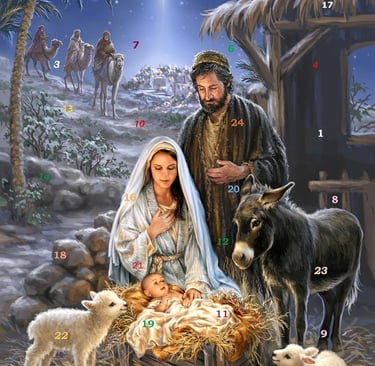Discover the Secret History of the Advent Calendar
Discover the Advent Calendar's fascinating history. Trace its evolution from 19th-century German religious customs to the global, chocolate-filled tradition we know today. Learn more!
By: Grace Callahan Byline: Biblical history enthusiast uncovering the deeper meaning of the Nativity.
11/3/20257 min read


A Christian's Quick Guide to Advent Calendar History
The origins of the Advent calendar are rooted in the Christian season of Advent, a four-week period of spiritual anticipation for Christ's birth, dating back to the 4th century. The calendar itself is a modern, tangible extension of much older German Protestant customs from the 19th century, such as lighting one candle or drawing a chalk line each day to mark the countdown to Christmas Eve.
The first printed Advent calendar was created in Germany around 1908 by Gerhard Lang, who was inspired by a handmade calendar his mother created for him as a child. His initial designs featured pictures behind small doors, serving a devotional and educational purpose rather than offering treats.
The tradition’s global popularity surged after World War II, when calendars were exported to the United States. They gained a seal of approval when President Dwight D. Eisenhower was famously photographed opening one with his grandchildren in 1953, boosting sales and transforming the custom into a widespread holiday staple.
While the tradition has largely evolved into a commercial countdown featuring chocolate, toys, and various gifts, its core historical purpose remains an act of mindful, daily preparation—a tool for families to slow down and reflect on the true spiritual meaning of the Nativity.
Table of Contents
Why Do Christians Count Down to Christmas? The Deep Roots of the Advent Season
From Chalk Marks to Cardboard Doors: The Birth of the Advent Calendar
World War, American Presidents, and the Chocolate Evolution
Chart: The Commercial Shift: When Did Chocolate Calendars Start?
Video: History of the Advent Calendar
Why Do Christians Count Down to Christmas? The Deep Roots of the Advent Season
The Advent calendar is not a modern invention but a creative, physical expression of a spiritual observance that stretches back over 1,500 years. The origin of the Advent calendar tradition lies in the Christian season of Advent itself, a four-week liturgical period of preparation, hope, and reflection.
The word "Advent" is derived from the Latin term adventus, meaning "coming" or "arrival," and in the Christian context, it signifies the dual arrival of Christ: the celebration of his first coming at the Nativity, and the anticipation of his second coming in glory. In the Western Church, this season begins on the Sunday nearest to November 30th (St. Andrew’s Day). Early observance can be traced back to 4th-century Gaul (France) and Spain, where it was a time of fasting and prayer for new Christian converts preparing for baptism during the Feast of Epiphany in January.
The Spiritual Significance of the Countdown
The initial purpose of Advent was not a rapid, commercialized dash to Christmas Day but a slow, deliberate spiritual journey. The earliest Christian communities emphasized the need for believers to prepare their hearts for the mystery of the Incarnation. The daily, methodical counting, which the modern calendar facilitates, mirrors this spiritual discipline.
Hope and Anticipation: The countdown builds a focused, daily sense of expectation, linking the current moment to the promised fulfillment in the Nativity story.
Theological Parallel: The concept of waiting mirrors the centuries of anticipation in the Old Testament, where prophets foretold the coming of the Messiah. The calendar, therefore, is a micro-cosmic reflection of salvation history.
This profound spiritual history provides the essential context for understanding how the seemingly simple tradition of the Advent calendar first took root.
From Chalk Marks to Cardboard Doors: The Birth of the Advent Calendar
The first known Advent calendar customs emerged in 19th-century Germany among Protestant families seeking tangible ways to make the spiritual anticipation of Advent meaningful for their children. As opposed to the formal liturgical schedule, these were simple, daily home-based practices that were easily implemented.
What Did the Earliest Advent Countdown Look Like?
The earliest forms of the Advent countdown were purely devotional and domestic. They were not commercially printed but were created by families themselves. The common practices included:
Chalk Tally Marks: Families would make 24 chalk marks on a door or wall starting December 1st, and children were permitted to wipe one away each day until Christmas Eve.
Straws in the Manger: A tradition where a new piece of straw was placed into an empty Nativity manger each day, ensuring the manger was softly prepared by the time Baby Jesus arrived.
Hanging Pictures: A new devotional image, often a religious or biblical scene, would be hung on the wall each day in December.
The Advent Clock/Candle: A marked candle (the Christstollen candle) was burned down to the next mark each evening, or a Weihnachtsuhr (Christmas Clock) was used to visually track the remaining days.
Who Invented the First Printed Advent Calendar? The Story of Gerhard Lang
The Advent calendar, as we recognize it with numbered windows, is largely credited to German publisher and printer Gerhard Lang (1881–1974). Lang was inspired by his mother’s childhood tradition, where she sewed 24 small cookies onto a piece of cardboard or put pictures behind little doors for him to access daily].
In 1908, Lang's printing company, Reichhold & Lang, produced the first commercially printed Advent calendar . It was called the "Munich Christmas Calendar" and consisted of two sheets: one with 24 pictures to cut out and a corresponding cardboard sheet with 24 fields onto which a new picture was pasted each day.
1920s Innovation: Lang further innovated by introducing the calendars with little perforated doors or windows that opened, a design that has endured to this day. Behind these doors, he placed either small pictures or Bible verses, keeping the calendar's content firmly rooted in its original religious context.
The Sankt Johannis Printing Company followed suit in the early 1920s, publishing calendars that exclusively featured biblical verses behind the doors instead of secular pictures, catering specifically to families prioritizing a devotional countdown.
The invention of the printed calendar provided an accessible, affordable, and reusable way for families to engage with the age-old Christian discipline of waiting and preparing for the Nativity.
World War, American Presidents, and the Chocolate Evolution
The history of the Advent calendar, like the history of Christmas itself, is intertwined with global events, from wartime scarcity to post-war consumerism. The calendar’s spread and subsequent commercialization mark its evolution from a strictly devotional item to a global holiday tradition.
The Impact of World War II and the Nazi Ban
The production and use of the traditional Advent calendar faced a major setback during World War II. Paper and cardboard were severely rationed in Germany, forcing companies like Lang’s to cease production.
The Nazi Party attempted to co-opt and secularize the Christmas holiday, even banning the printing of calendars with traditional Christian images. They produced their own version of a "pre-Christmas calendar" which replaced Nativity scenes and biblical verses with imagery promoting the Third Reich, such as swastikas, tanks, and other wartime symbols. This dark period underscores the resilience of the traditional calendar, which symbolized the spiritual hope the regime attempted to suppress.
Post-War Revival and American Popularity
After 1945, there was a deep public desire in Germany to return to traditional customs. Richard Sellmer Verlag in Stuttgart played a critical role in the revival, publishing the classic "The Little Town" calendar in 1946. These traditional, snowy town scene calendars were quickly exported to Europe and the United States, often brought home by returning American soldiers.
The turning point for mass American popularity came in 1953 when President Dwight D. Eisenhower was photographed opening a Sellmer Advent calendar with his grandchildren. The image, published in national newspapers, gave the calendar a "seal of approval," transforming it from a niche German custom into a widely accepted part of the American Christmas holiday.


FAQ Section
Q1: What is the difference between the Advent Calendar and the Advent Wreath?
A: The Advent Calendar traditionally begins on December 1st and has 24 openings to count down the days to Christmas Eve, focusing on a daily, chronological countdown. The Advent Wreath is a distinct, older Christian liturgical tradition that focuses on the four Sundays of Advent, with four candles (often three purple, one pink) representing the themes of Hope, Peace, Joy, and Love.
Q2: What kind of religious images were behind the doors of the first printed calendars?
A: The images behind the doors of the first calendars published by Gerhard Lang were typically simple devotional scenes related to the Christmas season, such as angels, shepherds, Nativity scenes, and winter landscapes. Later calendars from companies like Sankt Johannis Printing Company specifically used Bible verses or short scripture passages for daily reading.
Q3: Why is the Nativity scene often hidden behind the largest door on December 24th?
A: The Nativity scene is reserved for the largest door on December 24th because it signifies the climax of the Christian story of Advent: the birth of Christ. The 24th is Christmas Eve, the night of the vigil, and the opening of that final window completes the spiritual countdown, revealing the full scene of the Incarnation.
Q4: How is a ‘Living Advent Calendar’ used in Christian communities?
A: A 'Living Advent Calendar' is a community tradition where a different home, church, or public building decorates a specific window to reveal a new festive or Nativity scene each evening from December 1st to 24th. This practice encourages neighbors to gather daily for a communal moment of reflection, scripture reading, or song, making the countdown a collective, shared spiritual event.
Q5: Is it wrong to use a secular Advent calendar with gifts or chocolate?
A: No, using a secular calendar is not inherently wrong, but the act offers a clear opportunity to introduce a spiritual component. Many Christian families pair the opening of a chocolate door with a brief reading from an Advent devotional, a verse from a Jesse Tree reading, or a prayer, integrating the fun daily moment with meaningful spiritual reflection.



Conclusion: The Enduring Gift of the Daily Countdown
The history of the Advent calendar is a beautiful chronicle of spiritual intention meeting cultural innovation. What began as simple, personal gestures of Christian discipline—a chalk mark, a burning candle—evolved into a beloved printed tool, perfected by German visionaries, that helps millions focus on the arrival of Christ.
The calendar's journey, from 19th-century chalk lines to the post-war global phenomenon, shows its adaptability. Whether it holds a biblical verse, a devotional image, or a piece of chocolate, its core function remains unchanged: it offers us the daily gift of intentional time. It forces us to pause, even for a moment, to reflect on the hope, peace, joy, and love that define the Advent season. This is the ultimate, enduring value for every Christian family: a daily, tangible reminder that the great event of the Nativity is drawing near.
